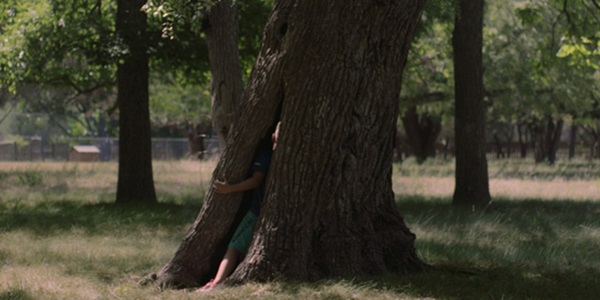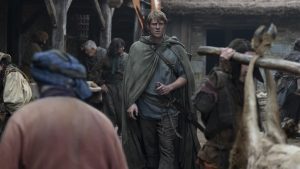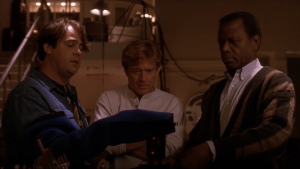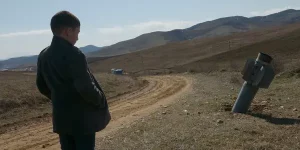
It’s all too easy for a lovely and languid day of relaxation to transform into something far more stressful and sinister. Such is the case in Family Portrait, the feature debut from writer-director Lucy Kerr, set on a beautiful summer day in Texas seemingly at the dawn of the COVID-19 pandemic. (Though wouldn’t it have made more sense for it to be winter? Still, the timelines of that period remain fuzzy to me to this day so I won’t press the issue.) Kerr’s depiction of a family hovering on the edge of an existential crisis is enigmatic almost to a fault; fortunately, the dreamlike visuals and swirling sounds of Family Portrait cast a spell on the viewer that only grows more powerful as the film grows more difficult to comprehend.
Together and Apart
As the sun rises on the riverside home where Family Portrait takes place, people awake and prepare to take a group photo for that year’s Christmas card before going their separate ways. The most determined to get this done is Katy (Deragh Campbell) since she and her partner, Olek (Chris Galust), must catch a flight home later that day. Katy and Olek appear to be the odd ones out of the otherwise close-knit Southern family; Olek is annoyed that Katy’s family thinks he’s Russian when he’s actually Polish, and that they make him feel guilty for the dietary restrictions that mean he must eat oatmeal instead of enjoying the big Mexican-style breakfast prepared by the family cook. Olek is also saddled with taking the family portrait instead of being in it since he and Katy are not married—yet another not-so-subtle dig at how they differ from the others.
source: Factory 25
Katy and Olek just want to take the photo so they can get on their plane; however, a succession of increasingly surreal events stand in their way. First, there is the news that a distant relative has just passed away suddenly in the hospital from a strange virus that no one knows much about. The whispered rumors of the reasons for her demise grow to a crescendo, adding additional layers to the already dense soundscape until the weight of it grows almost suffocating. Katy just wants to take the photo and get out of there—but then her mother disappears. Where has she gone? Why is no one else besides Katy concerned? And when are they ever going to take the family portrait?
On the Verge
Anyone who has ever felt overwhelmed at a family gathering will no doubt find a lot to relate to in Katy’s increasingly fruitless quest to gather her family members together; like leaves on the current of the Guadeloupe River that runs nearby, they keep slipping through her fingers no matter how much effort she exerts to keep them from floating away. This feeling is emphasized by the fluidity of Lidia Nikonova’s Steadicam cinematography, which follows Katy throughout the grounds as she searches for her mother and encounters various other members of her clan, all of whom seem to be clinging desperately to the last scraps of serenity on offer before returning to their lives in the real world. The warm, golden sunlight that dapples the tree leaves and river water only adds to the dreamlike feeling of the setting—though, in Katy’s case, it’s more of a never-ending nightmare.
source: Factory 25
What really makes Family Portrait stand out, however, is the sound design. What initially feels like an utterly realistic depiction of the sounds overheard at a family gathering—children playing, footsteps fading, dishes clattering, not to mention unintelligible voices seeping through the walls from other rooms—gradually grows more and more ominous, with certain sounds rising to the fore and others receding into the background to create a growing feeling of dread that contrasts with the beauty of the visuals. The sound is so layered and complex that it almost overwhelms everything else in the film; you find yourself straining your ears to see if there is something else you’re not hearing, something that will provide a clue as to what is going on. As the audio buzzes and drones in your ears, you too feel as though you are being driven to the brink of madness with Katy. If the film were any longer than it is, you probably would be, but Family Portrait clocks in at a succinct 78 minutes and so manages not to overstay its welcome.
The sprawling ensemble cast of Family Portrait makes for a believable family unit, though it helps that they all coalesce around a star as bright as Campbell. One of the most interesting actors working in independent film right now, Campbell has the kind of honest, open face that makes her feel like someone you know (and like) personally. She’s instantly relatable, even when—especially when—embodying complicated characters like Anne, the socially awkward daycare worker whose life is changed when she discovers skydiving in Anne at 13,000 Ft. Her performance in Family Portrait grounds the strange happenings of the film in something real and understandable and almost single-handedly keeps it from floating off into the ether.
Conclusion
An almost mystical exploration of anxiety and melancholia and the way they can take hold of your mind, Family Portrait is all the more intriguing for all that Kerr leaves unsaid and unexplained. It’s hard to think of a film that better captures the underlying sense of menace seeping into the monotony of everyday life that characterized the early days of the pandemic.
Family Portrait opens at Metrograph in New York on June 28, 2024.
Does content like this matter to you?
Become a Member and support film journalism. Unlock access to all of Film Inquiry`s great articles. Join a community of like-minded readers who are passionate about cinema – get access to our private members Network, give back to independent filmmakers, and more.






